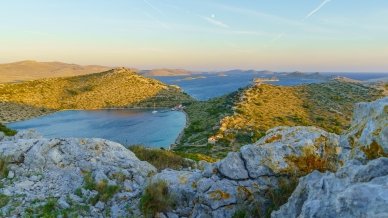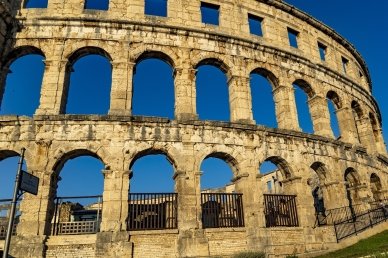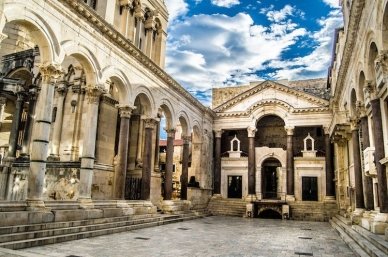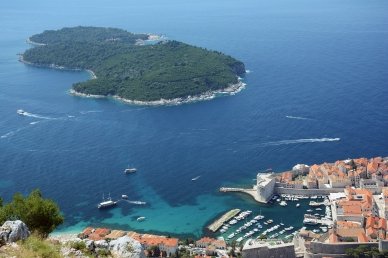Croatia

The country of a thousand islands where only 50 are inhabited, the homeland of a tie and Dalmatian dogs, and simply the blessed corner of Europe are the first things that remind about Croatia.
National parks, the cleanest lakes, and, sure thing, famous beaches make this small piece of Balkans one of the most visited places on the European continent.

General Information
Till the beginning of the 1990s, Croatia was a part of SFR Yugoslavia, a federal state in the south of Europe. In 1991, it announced its secession and creation of a new independent republic.
Historical Background
During its bimillennial history, Croatia has existed for a total of 700 years as a separate country. Initially, it was the Croatian Kingdom, a mighty state that was thriving till 1102. At the beginning of the 11th century, the ruling dynasty divested themselves from an authority, and Croatia united with Hungary as a personal union.
Then there were the centuries of power of all kinds. The Hungarian rule was changed by the Ottoman dictatorship, and some regions became parts of the Republic of Venice or managed to retain their independence.
In the 16th century, all Croatian regions gradually fell under the control of the Habsburg Monarchy and remained within the Austro-Hungarian Empire till World War I of 1914.
The fragments of a collapsed empire united as a new Kingdom of Serbs, Croats, and Slovenes. Eleven years later, in 1929, the country renamed the Kingdom of Yugoslavia where Croatia acquired a status of a separate territorial unit (banovina).
World War II brought new changes. The regime of Ante Pavelic was established as a fascist country that depopulated thousands of Serbs, Bosniaks, Jews, and Gypsies.
After the war, a new country appeared in the Balkans. First, it was the Federal People’s Republic of Yugoslavia, which later became the Socialist Federal Republic of Yugoslavia and comprised six countries. Croatia was among them. Yugoslavia remained one of the most prosperous socialist states.
At the beginning of the 1990s, an internal conflict between Serbs and Croats began. In 1991, Croatia separated, and a full-fledged five-year war on its territory began. The republic within Croatian borders was reclaimed in 1998, but the country’s economy still undergoes some difficulties. Some regions where secessionists organised their playground lag behind the rest of Croatia even 25 years later.
At present, Croatia is an independent parliamentary republic. It is also a member state of OSCE, the Council of Europe, the United Nations, and NATO - the world’s and Europe’s leading organisations.
Croatia joined the European Union in 2013 after the results of the national referendum.
Geography and Climate
Geographically, Croatia consists of two parts - continental and Adriatic. The first is very remote from the seashore and is located in the basin of the right Danube’s tributary - the river Sava.
The second is the one where beaches are extremely crowded with tourists during the high season. The only thing that may add up some thrill is the possibility of small earthquakes that happen here from time to time.
Croatia borders five countries. Four of them are the former SFR Yugoslavia parts: Serbia, Bosnia and Herzegovina, and Montenegro. The Croatia-Hungary border stretches to the northeast and is 400 km long.
The water area of the country involves more than 1,100 islands, the largest of which are Krk and Cres. Almost all Croatian islands are uninhabited. People have settled only on 50 of them.
The climate is very mild. It is never cold in winter and never too hot in summer. Winter temperatures range from -10°C to +10°C and depend on the locality. In the resort areas, summer temperatures may reach +30-35°C. It also rains very rarely. The high season begins in July and lasts till October.
Population and Language
Croatia is a small country with a population of 4 million people. The majority are Croats, and the other ethnicities are national minorities. The official language is Croatian, however, the languages of minorities can also be used officially.
Most Croats are Catholics (85%), but there are also Orthodox (4%), Islam (1.5%), and Atheist (4.5%) population, and those who follow some other religions.
The biggest Croatian cities are the capital city Zagreb (population of 800,000 people), Split (around 200,000 people), and Rijeka (around 130,000 people).
The official currency is the Croatian kuna. Though the country is an EU member, the euro is not planned to be introduced.
UPD: From January 1, 2023, the new currency of Croatia is the euro.
A visa is needed to enter the country for 90 days. Though Croatia has not joined the Schengen area yet, tourists with Schengen visas are allowed to stay without applying for a separate Croatian visa during the same period.
UPD: Croatia joined the Schengen area on January 1, 2023.
Directions
The best option of getting to Croatia as well as to any other Balkan country is air travel. There is a flight connection with all European countries. The flights do not take a long time and are inexpensive. The longer the distance, the higher the price. Tourists may opt for such airlines as RyanAir, WizzAir, LOT, KLM, and others.
Both travel agencies and private carriers deal with bus tours to Croatia.

Accommodation
The five best ways of finding a lodge in Croatia for several days or longer include hotels, motels, rented apartments, and country houses. A camping site or a hotel room will be most suitable for a short trip. Those who are planning to stay longer should look for the options of rented accommodation.
Tourism in this Balkan country is well-developed, so there are many hotels. Particularly, there is a vast number of budget-friendly three-star hotels. The average prices are almost the same as in Europe - €30 per night and higher.
Tourists’ feedback about Croatian beach hotels is contradictory. While some of them are delighted with quality service, the others outrageously list the minuses.
When booking a tour to Croatia, it will be necessary to take into account that non-smokers feel much discomfort here. And it is the hardest for those who come with children.
People smoke everywhere, be it a hotel room, a floor, beach, or even a swimming pool. Complaints will be of no effect. Widespread smoking is a common thing for the countries of former Yugoslavia.
Below are several affordable hotels and hostels in Croatia:
- Giovanna Guesthouse is a three-star hotel in Kaštel Lukšić, not far from Split. It provides small rooms, a shared kitchen, shower, and toilet. Free Wi-Fi and parking. The beach is nearby.
- Eros Hostel is a two-star hostel with separate and shared rooms in Split. It offers comfortable beds, air-conditioning, free full-cycle laundry, Wi-Fi, and a kitchen.
- Sobe Gorana is a mini-hotel in Živogošće with direct access to the beach. There are plain rooms with comfortable furniture and air-conditioning.
- JADRAN HOTELI d.d. is a hotel for spending a holiday with children in Kraljevica, not far from Rijeka. It is located a short drive away from Risnjak National Park. The rooms have plain but comfortable furniture. The kitchen is shared.
- HI Hostel Zagreb is a youth hostel in Zagreb with shared and separate rooms. There is free Wi-Fi and parking. The hostel also offers cots for small children.
The websites offer a lot of options for renting an apartment from Croatian landlords in resort cities and the capital. For instance, Interhome provides apartments and houses for families or big groups of people. As a result, renting accommodation in Croatia will be much cheaper than living in a hotel.
Places to See
Fabulous nature is the main attraction of Croatia. Lakes, national parks, and the Adriatic coast enchant everyone who comes here.
Plitvice Lakes
"If the God wanted to create a paradise on Earth, he would have chosen the Plitvice Lakes for this purpose" is the thought that comes to mind when you first see their immensity.
The terrain of immense beauty has been formed for several centuries due to 16 big and 10 small lakes, more than 100 waterfalls, and 20 caves under them.
Fifty years ago, these places were absolutely wild. Only several paths trodden by a human being could be found in virgin beech forests. Reclaiming of wild nature began in the middle of the 19th century.
Sidewalks and bridges started to appear first in the reserve. The next was an environmentally safe railway and several electric motorboats and ferries.
Barbecues, bonfires, and loud music, which tourists adore so much, are strictly prohibited. In 2008, after several desperate divers died, a ban was put on swimming too. Visitors may take their dogs only on a leash.
Such a caring attitude of the Croats towards one of the most beautiful places in the country does not always make sense for the guests. However, it yields the results. Despite the year-round influx of visitors, environmental experts manage to maintain a fragile balance of flora, fauna, and water resources. And thus these activities help create this fantastic spectacle.
The unbelievable beauty of Plitvice lands predisposes to unhasty reflections on the beauty, spawns the meditative mood, and relaxes. People who come here want to find a distraction from the frenzy of life most of all.
The reserve is located 135 km from the capital of Croatia. Bus rides are available from Zagreb bus station to Plitvice Lakes every day and usually take around two hours.
Kornati
The other pride of Croatia is this national park that consists of 89 islands. The Kornati archipelago area is around 220 square kilometres together with the water area. Without waterways, it constitutes only 50 square kilometres of incredible beauty.
The crowns of 100-metre long rocks jut out of the crystal clear blue waters of the Adriatic. Their height under the water is almost the same. As well as in Plitvice, there are some bans. Tourists may feast their eyes upon the crowns and take photos of them, but climbing up and diving from the rocks is strictly forbidden.

Kornati, Croatia
The islands are totally desolate, but human presence is still felt: once there was the Tureta Fortress constructed on those rocks. Though the walls are almost in ruins, the creation of the Byzantine architects attracts tourists in a particular way. They have their eyes glued on a breathtaking panoramic archipelago view and can take startling selfies and photoshoots here to create glamorous posts on social networks.
Guided tours usually take place by yacht: there is no other way to get to the Kornati. Apart from the fortress and rocks, tourists are offered to see the Telašćica bay - one of the largest and safest in the Adriatic. There is also saltwater Lake Mir, the waters of which are considered healing.
The archipelago is located not far from Zadar and Šibenik, the cities in the central part of the Adriatic.
Pula Arena
Though the Colosseum of Rome is considered the world’s most ancient amphitheatre, there is another older monument called the Pula Arena.
Once it used to be a very important city in the Roman Empire: it protected Istria from external enemies due to its advantageous location.
In the I century AD, Emperor Augustus gave the order to construct a wooden amphitheatre so that local residents could get their portion of spectacles after hard work.
The arena was extended due to the stone construction much later, during the rule of Emperor Claudius. The extension enabled holding the regular gladiator fights.

Pula Arena
Emperor Honorius banned the combats, and therefore, this popular construction began to decline gradually. Over the centuries, the amphitheatre turned into a grazing area where animals were roaming around the tribunes and chewing dry grass. The tribunes were then torn apart by city residents who took all the pieces to repair or restore their houses.
Even after 1,500 years, humanity still can admire the creation of the Ancient Greek architects owing to the Italian architect Pietro Nobile. He was the first to restore the remaining arena sectors. The last Holy Roman Emperor Francis became the patron of that high-minded initiative.
At present, it is a well-preserved monument of ancient times. At least, the Pula Arena is the only place among all existing today. All three architecture orders and four towers have been completely saved.
The Arena has undergone several grand reconstructions. In the first third of the 20th century, the theatre was rebuilt for concerts and plays. However, there was a considerable loss in seat capacity. Instead of the former 20,000 seats, now there can be only 5,000 spectators at the same time.
The Pula Arena is one of the most visited places in Croatia. During the whole summer, spectacular concerts and enchanting shows are held in the background of ancient ruins.
The admission fee is 20-25 Kn. In summer, concerts usually last till midnight, and in the low season, the amphitheatre is open till 7 p.m.
Diocletian’s Palace (Split)
This is where the filming of the cult-favourite blockbuster Game of Thrones was taking place, in the historical centre of Croatian Split. Two thousand years ago, a slave’s grandson, a former legion warrior, and abdicated emperor Diocletian constructed his palace there.
He was so obsessive in his endeavour to get the power since his childhood. However, that turned out to be an increasing burden for a person from the lowest echelons of ancient Roman society. Having taken pleasure in it to the full, Diocletian gave up everything and decided to build a palace to spend the rest of his life growing cabbage.
The choice was in favour of the Greek colony Aspalathos located on the Adriatic coast. The garden gradually extended around the plantsman’s palace and became known as Split. People from all over the coast used to seek protectorship there.

Diocletian’s Palace (Split)
At present, the palace is much reconstructed and almost does not look like the previous emperor’s chambers. However, it is still a very extensive territory: three palace hectares comprise a building and an inner bailey with two streets and three towers.
Once there used to be several temples in tribute to Roman goddesses, luxurious private quarters of the emperor, colonnades, and a mausoleum. Among all those magnificent things, the latter one has remained as a cathedral as well as the Temple of Jupiter that has become a baptistery.
All these historical sites are perfectly coupled with modern shopping malls, cafes, and restaurants in the centre of Split.
Lokrum
This small piece of dry land in the Adriatic close to the Dubrovnik resort was called “the cursed island” in the 11th century by St. Benedict Order members. They built their abbey from scratch, beautified the nearby territories, and began their happy life in prayers and work.
Everything came to end when Napoleon Bonaparte took fancy to this territory for his future fortress. Helpless monks were cast out, and the monastery was destroyed. And Fort Royal Castle was built on the highest mountain.
Reverend fathers could not confront the emperor’s will and they had no choice but to leave the island. Their only revenge was to put an everlasting curse on anyone who will make an attempt to obtain the shelter that was once taken away from the exiles.
Thus every new owner of the island underwent a tragic plight and died under different circumstances. Since then, the island has been desolate. Only a multitude of wild animals and musters of peacocks maunder about.

Lokrum, Croatia
A guided tour to the ‘Cursed Island’ is an opportunity to see the monastery itself, which was rebuilt into a palace long ago, the ill-fated Fort Royal Castle, and an awesome botanical garden. A walk to the Dead Sea will be of no less interest. Moreover, tourists may have a good rest after a tiresome walking tour at one of the beaches.
The groups willing to have a guided tour are usually gathered in Dubrovnik and transferred to the island by water taxi that departs from the local bay.
Food
Croatian cuisine is a diversified phenomenon. It is also extremely interesting due to the country’s geographical location. The influence of Hungary is stronger in Croatia’s continental part: that is how the cooking tradition of frying products in lard and abundant peppering has appeared. Food in Croatia is fattening and filling. As a rule, meat-based dishes, sausages, raw and cooked vegetables prevail.
The number one meat in Croatia is mutton. It is used for cooking lump dishes, sausages, stewing, and roasting.
They eat pork to a limited extent and use it for cooking legendary kulen, the sausage made of minced pork and spiced with a lot of pepper and paprika that give it a bright red colour. Pork chops may be also found in cobanac, the meat stew that contains not less than three types of meat.
The cuisine of the coastal areas is strikingly different. The light and exquisite food has been borrowed from the French, Italians, and Greeks. It contains more fish, seafood, herbs, and spices, and, as a rule, is fried only in olive oil or entirely grilled.
A traditional snack at home and restaurants is Croatian pršut, thin slices of smoked or jerky pork gammon. There are Dalmatian and Istrian kinds of pršut. In Dalmatia, the gammon is usually smoked while in Istria it is wind-dried.
The Croats are particularly proud of the Istrian pršut as a national snack. No banquet can do without the plates full of limpid reddish slices of jerky gammon, which is often served with Pag cheese, olives, and even melon.
Croatian dinner traditionally is about soups like chorba, goulash, or manestra. The first one is widespread not only in Croatia but across the entire Balkan peninsula. Chorba is usually cooked in beef broth with meat chops, red wine, vegetables, and fresh herbs.
Goulash stems from Hungarian cuisine and has gained its popularity in all South European countries.
Manestra is a mix of legumes like peas, corn, and beans. The soup is then thick, filling, and incredibly flavourous due to pork ribs, spices and herbs.
A typical second course of Croats will be ragouts of all kinds, casseroles with potatoes and vegetables, or sarma (a type of sauerkraut rolls with pršut pieces that add a peculiar zest to rice).
Desserts make a significant part of Croatian cuisine and involve both plain country dishes and exquisite sweeties.
Local people like yeast pastry like orehnjača (walnut roll) and makovnjača (poppyseed roll) that are traditionally baked by old ladies as inexplicable parts of the banquets.
Skradinska torta is a Croatian wedding cake that originates from Skradin. It is one of the most exquisite desserts well-known out of the country. Once it used to be baked by the brides before their wedding, but now people bake it for many other celebrations.
The cake requires quite expensive ingredients. Apart from eggs, honey, flour, and butter, it has to be flavoured with rose water and complemented with almonds and other nuts. A spoon of rum is one more essential constituent that renders a light savour for this dessert. The cake is decorated with chocolate coating and curls, orange peels, and walnut halves. A piece of Skradin cake is definitely worth coming to Croatia to taste it.
The other typical Croatian delicacy is a fluffy pudding called rožata. The name stems from the rose liquor used for dribbling this tender caramel dessert. Everyone who is partial to puddings will enjoy delicious and unusual rožata.
Zagorski štrukli is the Croatian cultural heritage dessert regarded as one of the main national dishes. It is served with cream sauce and filled with cottage cheese. You will definitely find this delicacy on the menu of any Croatian cafe or restaurant.
Alcohol in Croatia involves the wines of local varieties, fruit liqueurs, and home-distilled vodka made of almost everything that grows in the countryside gardens. The most popular wines are Prosek, Malvazija, and Graševina. The names of hard spirits speak for themselves: slivovitz is a plum brandy or rakija, and travarica is a variety of herbal rakija.
The list of fruit liqueurs is very long as they are made of any possible fruit, such as raspberries, apricots, cherries, apples, etc. However, these spirits contain no more than 20% ABV.
Croatian cuisine is always so tasty and authentic, and worth a special gastronomical tour to the coast of the Adriatic Sea.
Croatia is a marvellous place for having a beach holiday, studying the history of the Balkans, and acquaintance with cooking traditions of the European south. Its nature is stunningly beautiful. And the way how Croats care about the environment can be compared only with the way how parents cherish their children. Croatia leaves an overriding impression and evokes a desire to be back there again and again.
FAQ
What is Croatia's population?
Croatia's population is approximately 4 million.
What is Croatia's territory?
Croatia's territory covers about 56,594 square kilometers.
What is the official language in Croatia?
The official language in Croatia is Croatian.
What organizations is Croatia a member of?
Croatia is a member of several international organizations, including the United Nations, NATO (North Atlantic Treaty Organization), and the European Union (EU).
Does Croatia use the euro?
Croatia joined the euro area on 1 January 2023
Is Croatia a Schengen country?
On 1 January 2023 Croatia became the newest member state to join the Schengen area.
What is Croatia best known for?
Croatia is best known for its stunning Adriatic coastline, historic cities like Dubrovnik and Split, and beautiful national parks.







